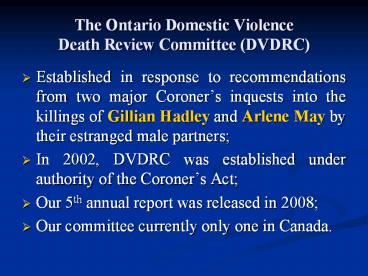The Ontario Domestic Violence Death Review Committee (DVDRC) - PowerPoint PPT Presentation
1 / 19
Title:
The Ontario Domestic Violence Death Review Committee (DVDRC)
Description:
The Ontario Domestic Violence Death Review Committee (DVDRC) Established in response to recommendations from two major Coroner s inquests into the killings of ... – PowerPoint PPT presentation
Number of Views:104
Avg rating:3.0/5.0
Title: The Ontario Domestic Violence Death Review Committee (DVDRC)
1
The Ontario Domestic ViolenceDeath Review
Committee (DVDRC)
- Established in response to recommendations from
two major Coroners inquests into the killings of
Gillian Hadley and Arlene May by their estranged
male partners - In 2002, DVDRC was established under authority of
the Coroners Act - Our 5th annual report was released in 2008
- Our committee currently only one in Canada.
2
The Ontario DVDRC
- Mandate To assist the Coroners office with the
investigation and review of deaths involving
domestic violence with the goal of making
recommendations aimed at prevention of similar
deaths - Review criteria Homicides of a person and/or
their child(ren) by an intimate partner or
ex-partner who may also have commit suicide
following the homicide.
3
The Ontario DVDRC
- Objectives
- (1) to conduct confidential, in-depth reviews of
some cases - (2) to maintain a comprehensive database on all
cases to identify trends, risk factors
patterns - (3) to identify systemic gaps or shortcomings so
as to make recommendations for improvements.
4
Reviews 2003-2007
- Total reviews 62 cases, involving 100 deaths
- Victims 94 women 6 men
- Accused 92 men 8 women
- Type of homicide event
- - 39 homicide only
- - 37 homicide-suicide
- - 6 multiple homicide-suicide
- - 3 multiple homicide
- - 15 attempt homicide-suicide
5
Reviews 2003-2007
- Type of relationship
- - 56 legal spouses
- - 26 boyfriend/girlfriend
- - 18 common-law partners
- Length of relationship
- - 61 10 years or less
- - 38 More than 10 years
- Children in common 58
6
Top 10 risk factors over 5-year period
- 1 Actual or pending separation (79)
- 2 History of domestic violence (75)
- 3 Perpetrator depressed (63 non-medical)
- 4 Obsessive behaviour by perpetrator (63)
- 5 Escalation of violence (50)
- 6 Prior threats to kill victim (45)
- 7 Prior threats to commit suicide (44)
- 8 Prior attempts to isolate victim (44)
- 9 Access to/possession of firearms (42)
- 10 Excessive alcohol or drug use (40)
7
Preventable deaths?
- The DVDRC considers a case predictable, and
potentially preventable, if there are 7 or more
risk factors present. - Between 2003-2007
- 84 of the cases had 7 or more risk factors
- 8 of cases had 4-6 risk factors
- 10 of cases had 1-3 risk factors.
- thus, the majority of cases appeared to be
preventable in hindsight!
8
Recurring Themes
- Multiple recommendations directed at some key
areas between 2003-2007, including - (1) Education
- (2) Risk assessment
- (3) Universal screening
- (4) Marginalized communities
- (5) Intersection of family and criminal law
- (6) Coordination of services.
9
Education Recommendation 11-2007
- It is recommended that the Ministry of
Education who provides funding for adult
education, alternative education programs, and
regular school programs that may involve young
parents, ensure that education and training is
provided to individuals who deal with young
parents in such programs on how to respond to
suspected or known cases of intimate partner
violence among their clients.
10
Risk AssessmentRecommendation 14-2007
- It is recommended that community agencies in
partnership with government should explore the
creation of an easily accessible, non-threatening
mechanism for friends and family to get
information or to consult with a trained
individual regarding situations where they have
concerns that a woman is at risk from her
intimate partner.
11
Universal ScreeningRecommendation 5-2007
- It is recommended that healthcare providers be
taught to be mindful of the dynamics of domestic
violence and the potential for lethality,
especially when working with patients who have a
history of drug abuse, depression, anxiety, and
suicidal ideation, particularly when there is
high conflict in their marriage and a history of
numerous separations.
12
Marginalized communitiesRecommendation 7-2007
- We recommend that first Nation communities be
prioritized by government to address the enormous
lack of resources available to them, including
making available culturally appropriate service
providers that would be adequately trained in
providing an effective response to the complex
issues facing Aboriginal families.
13
Intersection of family/criminal
lawRecommendation 24-2004
- It is recommended that before deciding on the
nature of access, assessment reports for family
court judges, prepared by qualified assessors
with domestic violence training, should be
considered. This assessment is especially valid
when dealing with someone who has a history of
domestic violence as demonstrated by a prior
criminal record for related offenses.
14
Coordination of ServicesRecommendation 11-2006
- It is recommended that a protocol be
established to ensure that when Childrens Aid
Societies (CAS) receive information about
domestic abuse from other professionals such as
school guidance counselors, that the information
be forwarded in a structured way to all
appropriate authorities, including police so that
monitoring of such cases should involve and link
all appropriate agencies.
15
- No blame or shame culture of reviews
- a must if committees are to achieve the 3Cs
communication, cooperation and collaboration a
crucial element in the prevention of domestic
violence related deaths.
16
Our ultimate goal?
- To understand and recommend change
- OR
- To understand and implement change.
17
Where do we go from here?
- Recommendation 1
- It is recommended that the Ministry of the
Attorney General take a leadership role in
creating an inter-ministerial committee that will
methodically review all community, agency and
government responses to recommendations that have
been made by the DVDRC since its inception.
18
Thank you!
19
To register go to https//rabbit.vm.its.uwo.ca/C
onfCDH/































